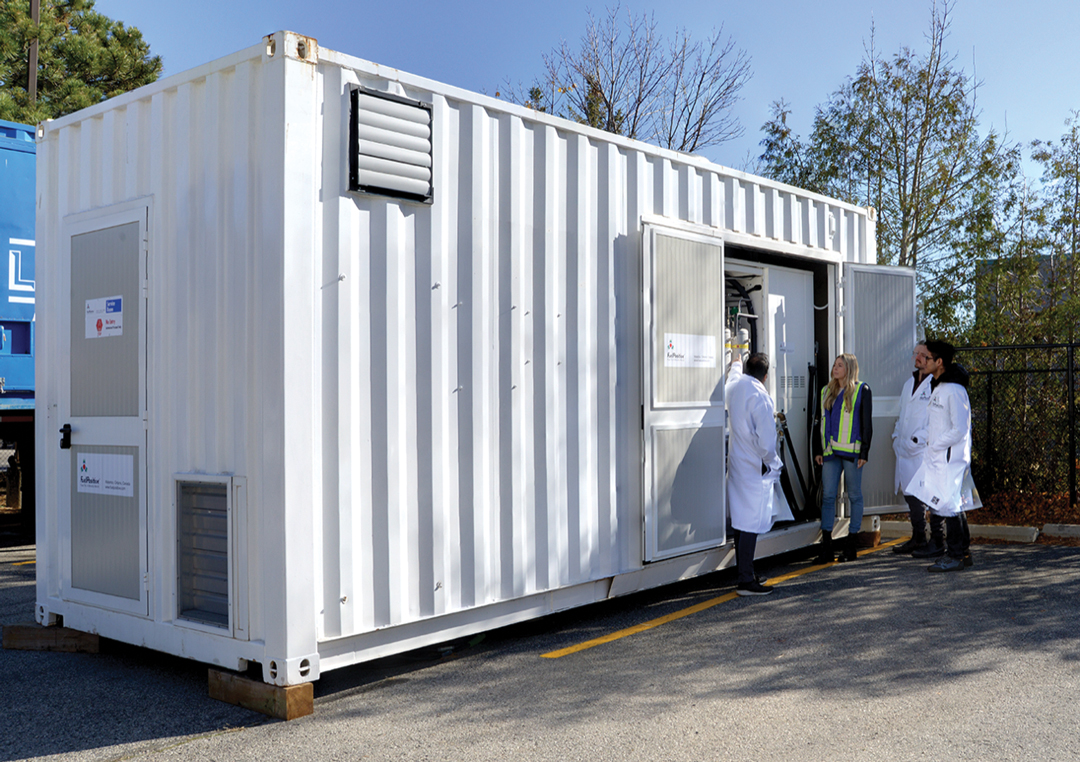REVOLUTIONARY FUEL AND FERTILIZER
BY IAN DOIG
FuelPositive of Waterloo, ON, has the ambitious goal to disrupt the global ammonia industry with its customizable, on-farm production system. These modular, containerized units would allow farmers to produce their own anhydrous fertilizer and, eventually, fuel. It’s a timely project given recent input cost fluctuations.
“Farmers are just so fed up with the inconsistencies and supply chain issues and cost issues,” said Ian Clifford, the company’s board chair and CEO. “They’d love to have technology on-farm that would give them stability and certainty for decades.”
The system uses a nitrogen generator to harvest the gas from the air and is paired with a water electrolyzer that generates hydrogen. Using the company’s proprietary conversion technology, the system produces ammonia from the two elements. The product is stored in steel tanks. With the use of a renewable electricity power source rather than fossil fuels that produce carbon emissions, the ammonia is considered green.
In 2022, the first pilot system was launched on an 11,000-acre Manitoba grain farm that has used anhydrous for more than 50 years. Two additional pilot systems are being developed.
Clifford envisions the system revolutionizing agriculture one farm at a time. “It’s thousands and thousands of systems ultimately deployed globally,” he said. Anhydrous production is the first step, and the company is also at work on an ammonia module that can produce fuel. The dual technology will allow farmers to stabilize input costs over time, said Clifford. “It’s like saying, ‘I’m going to offer you gasoline for a dollar a gallon, and that’s what it’s going to cost for the next 20 years.’”
Over the next two years, if all goes according to plan, FuelPositive will manufacture about 30 of the units in small batches while it ramps up a high production manufacturing facility. The company has received interest from potential buyers for around 200 systems. “Our challenge is going to be keeping up with demand, and how do we keep improving this technology?” said Clifford.
The first version of the system produces 100 tonnes of anhydrous per year, but an updated unit can crank out 500 tonnes. The pilot farm typically uses 500 to 600 tonnes annually. A farmer can stack the shipping container-like modules to meet their unique fertilizer requirements, and the company can additionally customize the system.
Prairie farmers are widely certified to handle anhydrous, which may encourage adoption of the system. On the flip side, to manufacture their own ammonia, rural farms require an adequate water supply and access to renewably produced electricity. Clifford cites Manitoba’s low-cost, largely green grid as supportive. And the water demand is relatively low with, for example, 450 litres required to produce 300 kilograms of anhydrous per day. Such geographically widespread, farm-based production is manageable, he said, whereas the localized water demands of a large-scale anhydrous ammonia plant are massive.
In areas where the electrical grid is not green, investment in on-farm renewable production may be required. “Farms with their own solar, wind or a combination thereof, could produce green ammonia entirely off-grid,” said Clifford.
The obvious potential benefit of the system’s environmentally friendly, green designation is carbon credit revenue that can be shared between the farmer and the company, which handles ongoing maintenance and operation. Also aimed at the bottom line, while FuelPositive remotely monitors and controls the system, it can optimize production with off-peak electricity usage. A variety of tax credits and emission reduction incentives are widely available to farmers for such green infrastructure development.







Comments